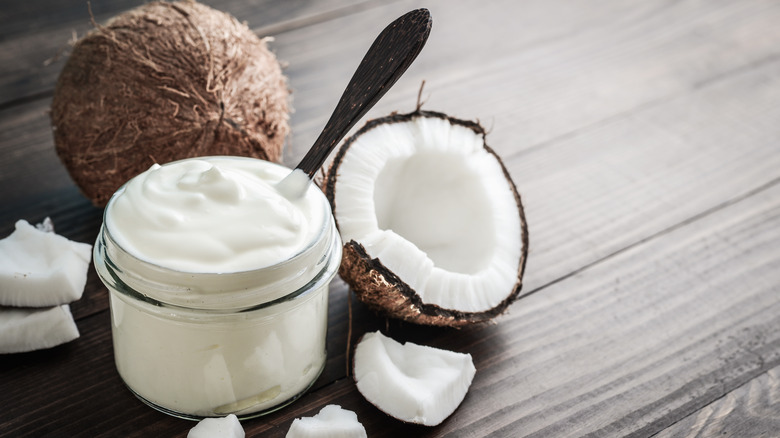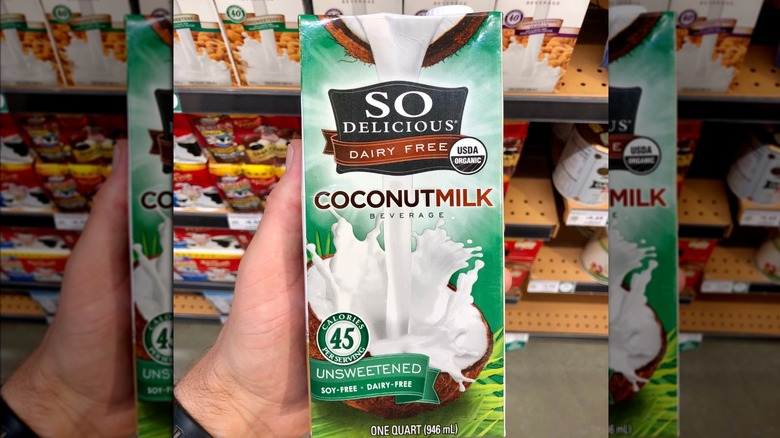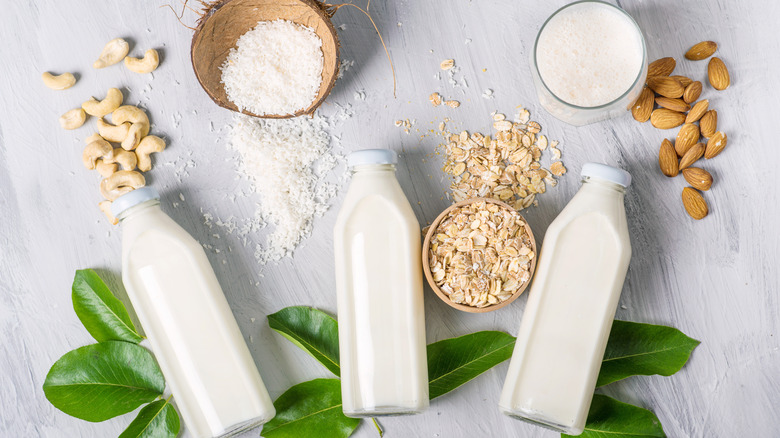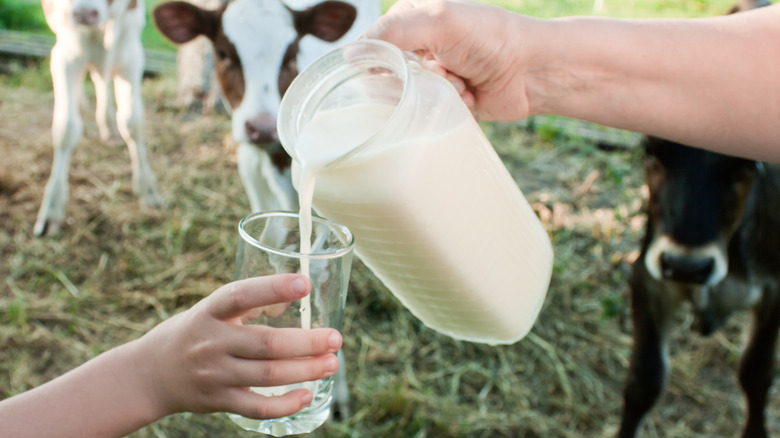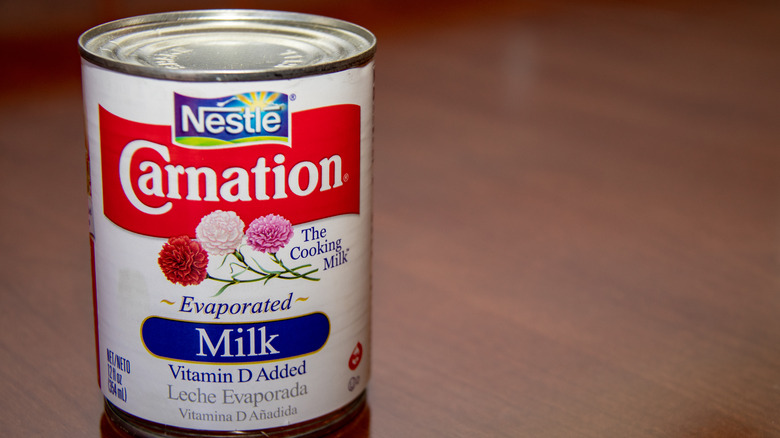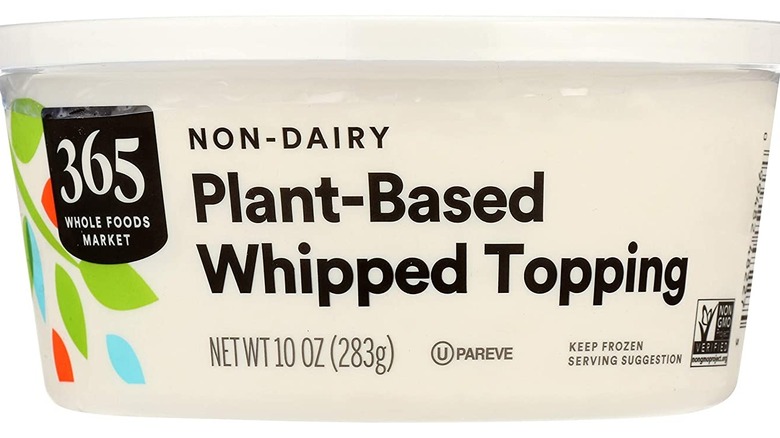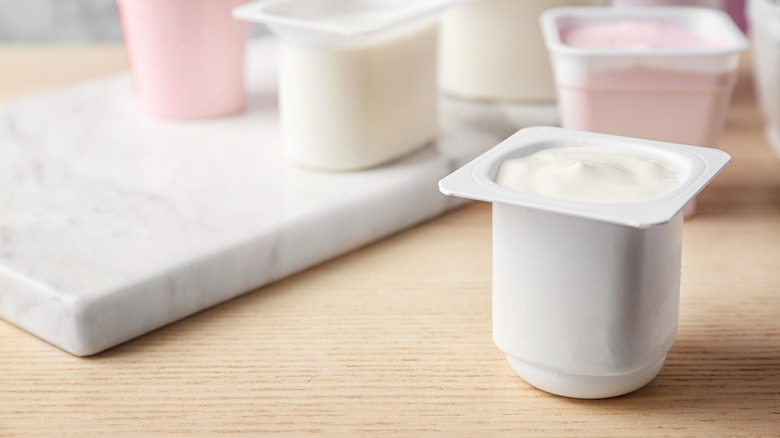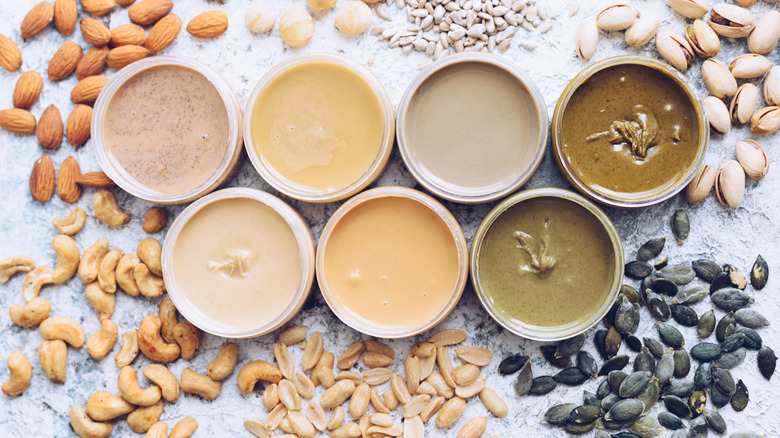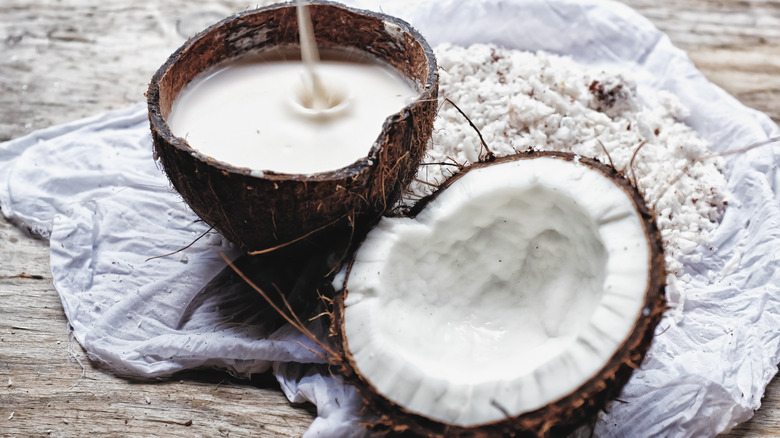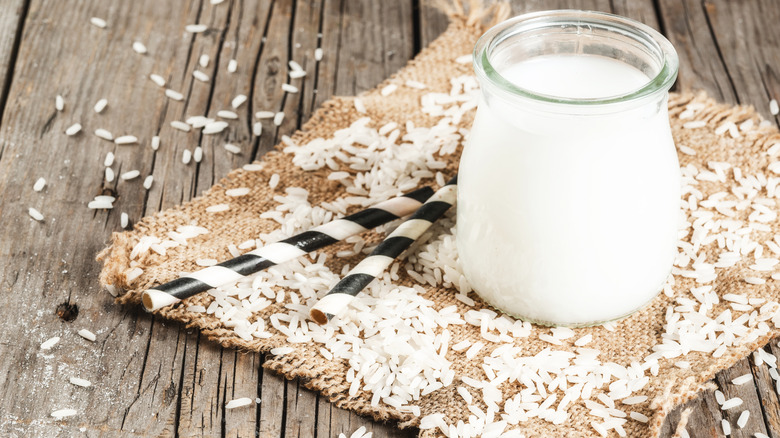10 Best Substitutes For Coconut Cream
We may receive a commission on purchases made from links.
Years ago, when you went to the supermarket to find coconut cream unless you were shopping in a specialty store or an Asian market, you may only have been able to find the sweetened kind (most likely Coco Lopez in its familiar blue can) as this has long been an ingredient of the perennially popular pina colada (or nonalcoholic versions thereof). Technically, this product is called "cream of coconut," and according to the Coco Lopez label (via Amazon), sugar is the number two ingredient, right behind coconut. These days, when you see a recipe calling for coconut cream, it's more likely that what is meant is the unsweetened kind that Bon Appétit says is made from coconut and water (plus maybe a stabilizer like guar gum). Pure coconut cream, however, consists of nothing more than the creamy solid that rises to the top when grated coconut is soaked in hot water (via BBC Good Food).
Coconut cream often features in Asian dishes like soups and curries, where it adds not only a rich, smooth creaminess but also a hint of fresh coconut flavor and a delicate sweetness even without any additional sugar being added. In recent years, coconut cream has also been gaining traction as a vegan dairy substitute and is often used in baking and for making desserts. If you do not have or don't wish to use coconut cream for a recipe, however, here are some ingredients that might be able to take its place.
1. Coconut milk
BBC Good Food explains that coconut milk differs from coconut cream in that the cream is skimmed off the top when coconut flesh is soaked in water, whereas coconut milk is the liquid that remains when the grated coconut is then strained through cheesecloth. Bon Appétit, however, says that coconut milk and coconut cream aren't as different as you might think. They actually have a very similar flavor, and the only real difference is that coconut milk is thinner as it contains a higher proportion of water.
The Stonesoup blog says that if you have limited pantry space, coconut milk is a better staple to keep on hand, as it can be used in place of coconut cream in most instances for a lighter, and perhaps healthier, result. Coconut milk might not always work for baked goods where a recipe specifically calls for coconut cream, though, since in baking, a change in consistency might throw off the whole recipe.
If you are using coconut milk in a soup or stew, substitute it on a 1:1 basis. If the result is a bit thinner than you'd like, you can simply cook the dish a bit longer so some of the liquid evaporates.
2. Plant-based milks
Many kinds of plant-based milk, such as those made from almonds, cashews, oats, or soybeans, have a similar consistency to coconut milk even though they have a slightly different flavor. They offer the same advantage when used as a substitute for coconut cream: they fit into a vegan diet. As with coconut milk, these types of non-dairy milk are best used in place of coconut cream in a stovetop dish such as a curry where the thinner consistency won't present much of a problem. Unless you're an expert at kitchen chemistry and know how to make the other necessary adaptations in a recipe, you might not want to use these as coconut cream substitutes in baking because most varieties of plant-based milk lack the fat content of coconut cream (via Allrecipes).
If you are using plant-based milk in place of coconut cream, substitute it on a 1:1 basis. As with coconut milk, you can always cook it a little bit longer to thicken it up a bit, or you can do as Substitute Cooking suggests and stir 2 teaspoons of flour into each cup of milk.
3. Dairy cream
If you are ok with a non-vegan substitute for coconut cream, then you can always use dairy cream. Gourmet Sleuth suggests using light cream, assuming you can find such a thing in your supermarket. According to AZCentral, though, light cream appears to be more of a regional thing these days, still popular on the east coast but not readily available elsewhere.
What if you can't find light cream? Stonesoup says heavy (aka whipping) cream is a good substitute even though it has slightly more fat than coconut cream. But if you want a close approximation of the texture, you can mix ¼ cup water with 1 cup of whipping cream. The author admitted they usually don't bother with this, however, since there's nothing wrong with a slightly creamier dish.
To use dairy cream in place of coconut cream, you can just replace the latter with an equal amount of the former, although you may wish to dilute heavy cream with a little water. Yet another suggestion, if you really want the coconut flavor, is to add ¼ teaspoon coconut extract per cup of dairy cream.
4. Whole milk
A slightly less satisfactory substitute for coconut cream, but one that will work in a pinch, is to use dairy milk – preferably whole milk. Using milk, of course, will automatically render any dish you make unsuitable for vegan consumption, although vegetarians may still be able to partake as long as they do dairy. Whole milk, unlike cream, may not have the necessary thickness to stand in successfully for coconut cream used in baking, but it could be used in something like a curry. It won't add a great deal of flavor, though, so you might want to compensate by using extra spices or other flavorings.
Substitute milk for coconut cream on a 1:1 basis, but bear in mind that the end results will be thinner so may require extra cooking. You can also use Substitute Cooking's favorite milk-thickening hack of adding 2 teaspoons of flour to each cup of milk.
5. Evaporated milk
For a great dairy-based substitute for coconut cream, try another product that comes in a can: evaporated milk. What is evaporated milk, anyway? Substitute Cooking tells us that it's the stuff you get when milk is cooked down and, well, evaporated. Water is released, milk solids remain, so you get a thicker, creamier, and sweeter-tasting substance that is really quite similar to a dairy version of coconut milk.
Note: evaporated milk is not the same thing as condensed milk since, as The Kitchn points out, the latter includes added sugar. While you could use condensed milk in place of coconut cream, it's not really recommended unless you want something super-sweet. Both types of milk, though, are better for use in desserts than in savory dishes.
Evaporated milk is somewhat thicker and a bit sweeter than coconut milk, so you should only use half as much of this ingredient as you would coconut milk. Maybe up to ¾, although even the latter amount will result in a noticeably sweeter dish.
6. Non-dairy whipped topping
One very popular use of coconut cream these days is as a vegan whipped topping. Coconut cream (or even canned coconut milk) can be whipped to a consistency similar to whipped cream. If you have no coconut cream, you can, of course, use whipped cream itself. But what if you are trying to avoid dairy products? While the first supposedly non-dairy whipped topping that comes to mind might be Cool Whip, it turns out that the stuff actually does contain dairy protein and in some cases even skim milk.
There are, however, a number of vegan-friendly dairy-free whipped toppings now available on the market. According to Go Dairy Free, these come in both the frozen tub and ready-to-squirt varieties. While non-dairy whipped topping is a great stand-in for whipped coconut cream used as a dessert topping, you should not use it as a substitute for coconut cream in baking and definitely not in savory dishes
If (and only if) you are using it as a dessert topping, you can swap out non-dairy whip for whipped coconut cream 1:1. Other uses are not recommended.
7. Plain yogurt
Yogurt – the plain, not the flavored kind – is something that can stand in for coconut cream in many recipes. You can either use the high-fat Greek kind or a lower-fat variety, as you prefer. The one thing you cannot do is to use yogurt in a recipe that needs to be boiled. Well, at least not before you boil it. Stonesoup warns that yogurt, when boiled, will curdle and look kind of gross. If you plan to use yogurt in a stovetop dish in place of coconut cream, what you can do is to wait until the dish is nearly done cooking and add the yogurt at that point. As long as the yogurt is not heated to a point above simmering, it should be okay.
Even though yogurt, even Greek yogurt, does tend to have a lower fat content than does coconut cream, it can still be substituted cup-for-cup.
8. Nut or seed butter
If you are planning to cook up a curry and you realize you're short on coconut cream, one option you have is to go in a somewhat different direction, flavor-wise. Instead of coconut, how about peanut, cashew, or almond, or maybe even sesame? If these options sound tasty to you, you'd be surprised at what a great coconut cream substitute you might be able to make from stuff you may already have in the pantry. Any type of nut butter (well, maybe not a chocolate-flavored one like Nutella) or else a seed butter like tahini can be transformed into a creamy cooking ingredient.
According to Stonesoup, you can make the equivalent of a 14-ounce can of coconut cream by mixing 5 ounces of nut or seed butter with 1 cup of water. They say it's best to add just a little water to the nut butter at first, mixing it in with a whisk, food processor, or blender. Once you have a slightly thinner paste, add the remaining water and use this mixture as a 1:1 swap for coconut cream.
9. Homemade coconut cream
If you have no coconut cream but you do have a fresh coconut on hand – or at least unsweetened flaked coconut – you can always go the DIY route by making your own coconut cream. For Eat's Sake uses 1 ¼ cups dried flaked coconut mixed with 3 cups of water, soaking the coconut for ½ hour and then using a blender set on high speed to pulverize the coconut for 60 seconds.
For Eat's Sake instructs to strain out the coconut pulp using a nut milk bag and then store the liquid in the fridge overnight. (The solids, too, can also be used in cooking.) In the morning, the coconut cream should have risen to the top, while the watery stuff on the bottom will be coconut milk. Alpha Foodie did much the same thing, only using fresh coconuts – about ½ cup of water per coconut. They also didn't bother with the soaking part.
Whatever recipe you use to make your own coconut cream, the cream can be used in exactly the same way (and in the same proportion) as you would use canned coconut cream.
10. Homemade rice milk
If you're a dedicated DIY-er but don't happen to have any coconuts on hand, there's still a very decent coconut milk substitute you can make from a staple item that nearly everyone has in the back of the pantry somewhere: a plain old bag of white rice. Sure, you can use store-bought rice milk, too, but if you're preparing it yourself, you can make the milk as thick as you like.
Minimalist Baker says the best way to make your own rice milk is to soak uncooked long-grain rice in hot water for 2 hours, then drain the rice and puree it in the blender with an additional 4 cups of water (or less water if you want thicker rice milk, as you probably would if using it in place of coconut cream). Add a tiny pinch of salt, too. Blend for a minute, then strain.
Substitute Cooking says to use rice milk in place of coconut cream on a cup-for-cup basis, adding that it works for both sweet and savory dishes.
